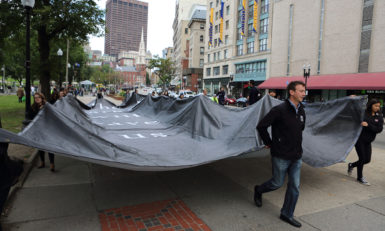On September 30th, I, along with a small group of skeptical but cooperative volunteer-participants, an eager and unassuming college marching band, and one very enthusiastic curator with a megaphone, gathered at the entrance of the historic Boston Common. Together we engaged in an hour-long performance centered on UK-based artist Bill Balaskas’s 80-foot-long banner installation entitled The Market Will Save Us.[i]

Bill Balaskas, The Market Will Save Us, 2016. Boston performance. Curated by Lanfranco Aceti. Photography by Hilary Scott.
True to the astutely presumptuous title of the loaned artwork and its equally spectacular size, Lanfranco Aceti’s curated performance of the piece consisted of a dramatic public procession of the enormous banner by its reserved participants. The group of solicited participants (myself included) was comprised mostly of the curator’s anxious graduate students. As we mingled with our fellow classmates, it became evident that our understanding of the piece was limited to the brief curatorial statement most of us quickly skimmed before attending the event. Likewise, onsite introduction on our intended role was brief. Dr. Aceti choreographed our formation. As if pallbearers preparing to gracefully escort a casket to its grave, on command we harmoniously lifted the banner and began our directed parade.
The theatricality of the performance ensued as we began circling the interior pathway of the park with the hefty artwork. We obediently marched to the combined sounds of forced academic solidarity, vis-à-vis the Boston University marching band, and Dr. Aceti’s humorous threats that he would deduct money from the volunteers’ modest wages if we did not “put some muscle into it.” Visually united by our instructions to wear all black attire, the processional act of horizontally carrying this heavy banner with the text facing upward towards the sky felt very much akin to a sort of tongue-in-cheek funeral procession. Paradoxically, the participants were encouraged to exhibit enthusiasm and spirit as the band played traditional rallying tunes that could only be described as something you would hear at a local high school’s pep rally.
Halfway through our procession we were directed to lay the banner flat on the central sloping hill of the park. As the banner lay momentarily still, we danced and clapped to the band’s upbeat tunes and watched as a talented participant spontaneously danced on top of the enormous banner. The brief interlude attracted a group of nearby schoolchildren, followed quickly by their seasoned chaperones. Almost immediately, Dr. Aceti approached the group and asked if they would allow a photograph of the children with the banner. Unable to conceal their growing skepticism of the event, the chaperones swiftly declined.

Bill Balaskas, The Market Will Save Us, 2016. Boston performance. Curated by Lanfranco Aceti. Photography by Hilary Scott.
Instinctively, I began to feel a sense of unease at the charade. As they were shooed away by their well-intentioned chaperones, I watched the children’s faces go from ones of intrigue and excitement to bewilderment. The performance suddenly read like a cheesy campaign ad ripe with contradiction. It felt as if at any moment we could be asked to grab the nearest mixed-race baby just in time for the photographers to snap a picture of our saintly deed. It was then that I felt a small twinge of shame and self-confessed naivety. Being in my twenties, this is a feeling which I have had the distinct pleasure of being well versed in.
Wincing at my willing participation in this spectacle, I found myself reflecting on this tension and discomfort long past the conclusion of the performance. I became increasingly aware of the imposed sense of hope and idealism echoed in our performance. My mind wrestled with the idea of the nature of participation itself. How do we participate socially, politically, economically? Are we always aware of this participation? Or are there times when we are each that naive schoolchild intrigued and excited by the acrobatics of spectacle? My gamble is yes. Much to my discomfort, I became critical of my own participation. Was I the ungrateful millennial secretly resentful of years of unpaid “participation,” or as our expensive higher education institutions like to call it, “internships.” Or was I the industrious entrepreneur acting with sincerity and genuine interest in engaging with my community? If I am honest with myself, I am most likely a bit of both.[ii]
Apart from my own, the performance in its urban context was met with varied responses. These reactions ranged from the confused expressions of commuting professionals and tourists who slowly read aloud the statement as if there was a question mark attached to it, to the local semi-permanent park residents who seemed to, at the very least, be energized by the excitement of the band and perhaps equally inspired by an all too relatable cheeky “f*** the man”-esque statement making a grandiose appearance within their local turf. However varied the responses to the piece, one reaction remained consistent with almost all that came in contact with the work: curiosity.
The technique of generating public curiosity with large-scale art and extravagant accompaniment within the contextualized boundaries of public domain is not a revolutionary concept that has evaded the surge of socially engaged art. Furthermore, as anyone can observe in our contemporary cultural institutions, bigger is in fact becoming better, or at least not as easily ignored by the masses (cue: Jeff Koon’s arrogant balloon animals made of stainless steel and LACMA’s public spectacle surrounding the arduous transportation of the boulder used in Michael Heizer’s Levitated Mass). Artistic, political, and/or social ideas presented at such a scale, whether overt or obscure, hold the potential of making meaningful impact and engagement just by the mere physical and consequential intrusion it presents in our day-to-day life. What Balaskas and Dr. Aceti’s collaboration presented was a clever and extremely relevant use of this technique. With this technique in mind, the performance sharply mirrored and prompted intense reflection on the age-old political tactic of diversion and spectacle.
I am sure readers can make their own conclusions as to the pertinent implications and connections that can be made in light of our participation in the most recent spectacle of US politics, especially when discussing divisive issues facing our socioeconomic future. However, that almost seems too easy. “The market will save us” is an undoubtedly ambiguous and omniscient statement. “The market,” by all accounts, can refer to both specific arenas of commerce and culture and to an abstract notion of the operation of supply and demand. Likewise, Balaskas’s use of the phrase “will save us” connotes a sense of social dependency and presumed certainty or trust in our socio-political systems. What this simple phrase and its extravagant intrusion into our public context exposes is not just a growing appetite for spectacle, but a very multifaceted participation in it. As analytic creatures navigating the world of global connectivity and the increasingly blurred lines between private and public domain, it is not surprising that along with our fascination and curiosity with spectacle comes our subsequent discomfort with it.

Bill Balaskas, The Market Will Save Us, 2016. Boston performance. Curated by Lanfranco Aceti. Photography by Hilary Scott.
The significance of this piece lies within this discomfort. The work’s wry diversion and contextualized versatility investigates the complex processes through which our social and political forces respond, react, and even at times distract in the face of crisis. This includes larger matters of participation surrounding the potential of, global implications of, and ultimately the recognition of economic crisis and systemic failure that all sectors of the market are susceptible to. Not too unlike a bad aftertaste that lingers in your mouth, we are reminded that the allure of diversion and spectacle is all too often inevitably spoiled by the unfavorable reality it was meant to conceal. As it relates to our socioeconomic systems, this festering reality is often a naive breeding ground for economic turbulence and marks an uncomfortable shift in one’s confidence in the once presumed infallibility of the global market. Balaskas’s banner and performance, The Market Will Save Us, is (excuse the pun) right on the money.
[i] Originally installed in 2013 on the exterior of the Royal College of Art in London, the banner embraced a new context as it participated in the 4th International Association for Visual Culture Biennial Conference, THE SOCIAL. Boston University hosted the conference, which presented work by keynote speakers and artists over the course of three days.
[ii] Following my interest in the participatory nature of this project, I asked curator, Dr. Lanfranco Aceti, to expand on his and Balaskas’s intentions regarding the involvement of the participants. Through a prompt email response, Dr. Aceti explained, “This was one of the most interesting parts of our conversations. We wanted for the participants to have fun, but at the same time reflect upon the very actions that they were performing, which were counterintuitive to the message of the banner itself and the apparent joy of the event simulated by the marching band and contrasted by the tyrannical solicitations via the megaphone for 'better work.' The idea was to create a disconnect that would not just criticize the market but also the aesthetic engagements within it. To be a cog in the machine was just one step of the whole process. We actually wanted the participants to reflect upon what they were participating in as much as the artist and the curator had done. If the artwork and its performance were to be observed by passersby, it also needed to be food for thought for the participants. What we were hoping for was for participants to realize that sometimes we participate in, engage with and enable situations which generate or perpetuate our own demise. We wanted for them to realize the complexity of the processes of exploitation which quite often, hidden behind the word participation, continue to propagate hierarchical systems of disenfranchisement within which we are obliged to take part with a smile. We really wanted for the participants to realize that the market would not save anyone and that the very idea of waiting for a savior (whatever this may be–the market, a strongman or another top-down institutional framework) would only bring to the fore tyrannical approaches. Ultimately what we hoped for was for the participants to realize that participation in itself is not sufficient; responsible and aware participation is actually the only way in which we can understand what we are supporting and being a part of. What I personally hoped for was that some of the people who held the banner would question the importance of responsibility and awareness in participatory social processes, particularly at a time when THE SOCIAL, as collective action and engagement, will become an important tool to voice concerns and contrast increasingly pervasive tyrannical frameworks of social control and economic exploitation.”



